Did you know bats are the number one predator of night flying insects? They feed on mosquitoes as well as numerous agricultural and forest pests, making them one of the best forms of pest control.
Interested in creating bat habitat where you live? Bats need all the elements of good habitat: food, water, shelter, and space to live. Providing only shelter won’t welcome in bats who were not living there already. If bats are not common in your area, it could be that your habitat is missing one of these other critical pieces. If you're looking for efficient, eco-friendly pest control, consider creating habitat that supports bats in Washington.

Unfortunately, Washington's 15 species of bat face many threats in our state including white-nose syndrome, habitat loss, insect declines, and wind turbine fatalities.
Creating habitat for bats where you live can be one small step to help support these important species.
Apply for our wildlife habitat certification program and sign. Our Habitat at Home program is free and open to all wildlife habitat types.
Apply for the Habitat at Home certification and sign
Download a printable application (PDF)
Neighborhood Bat Habitat
Bats need specialized food, water, and shelter resources, and they need a lot of space! If you're unable to provide all of the habitat requirements for bats, consider getting your neighbors or local community space on board. Ask someone to build a water source for bats and others to put up bat houses. Share bat gardening tips with your neighbors. The more food, water, and shelter options for bats, the better!
Food
While bat diets vary greatly around the world, all Washington bats eat insects.
You can support their food supply by planting native plants that support night flying insects. Flowers with white and light-colored blooms, or flowers who produce fragrance attract insects that bats eat such as moths, beetles, flies, gnats, mosquitos, and more.
A major food source for bats in the Pacific Northwest is moths. Moths are abundant at night and provide excellent nutrition for bats and other native species, including invertebrates such as beetles and spiders, as well as birds, amphibians, and small mammals. The larval form of moths (caterpillars) have evolved to thrive on native vegetation. In turn caterpillars feed numerous native animals and are essential food for young birds. Moths are also important native pollinators. When moths obtain nectar from flowers they brush up against the plant’s pollen, which is transported by the moth from plant to plant.
Reduce or eliminate your use of pesticides. Using pesticides not only affects insects but can also harm predators like bats and birds who eat insects as a main staple of their diets. Avoiding harmful pesticides, even switching to non-toxic pesticide alternatives, supports native insects and keeps bats healthy.
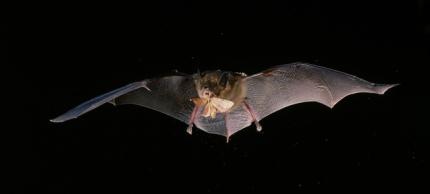
When designing your space, think about bats and all nocturnal wildlife. Bat Gardens help support 50 percent of nature activity that occurs after dark.
Native plant list* (Statewide)
- Flowering currant (Ribes sanguineum & Ribes aureum)
- Mock orange (Philadelphus lewisii)
- Trillium: coast trillium (Trillium ovatum) and sweet trillium (Trillium albidum)
- Clustered wild rose (Rosa pisocarpa)
- Nootka rose (Rosa nutkana)
- Serviceberry (Amelanchier alnifolia)
- Woolly sunflower (Eriophyllum lantanum)
- Yarrow (Achillea millefolium)
- Tall evening primrose (Oenothera elata)
- Long-leaf evening-primrose (Taraxia subacaulis & Taraxia tanacetifolia)
- Evening primrose (Oenothera curtiflora)
- Spreading phlox (Phlox diffusa)
Native plant list* (Eastern WA only)
- Tall evening primrose (Oenothera elata)
- Common blazing star, blazing star mentzelia (Mentzelia laevicaulis)
- White-stem blazing star (Mentzelia albicaulis)
- Stemless evening primrose (Oenothera caespitosa)
- Pale-stemmed evening primrose (Oenothera pallida)
- White sand verbena (Abronia mellifera)
- Showy phlox (Phlox speciosa)
Pollinator meadows can also be very beneficial to bats, as open meadows that attract bees and butterflies also tend to attract nocturnal pollinators and a wide diversity of other insects. Replacing a traditional lawn with a pollinator garden or meadow supports increased biodiversity at all levels.

Left to right: pFly, John Rusk, Frank Mayfield, Jan Jung, James St. John.
*Plant lists curated by Washington Native Plant Society/Walter Fertig
Water
Water is essential for wildlife, including bats. Bats drink “on the wing” and rarely land to drink. This means they need large freshwater sources that are free of pollution to give them the space to swoop to reach water. Water troughs, filled high and refreshed often to keep them clean, and ponds can provide water for bats, but if you can’t install such a large water feature, you can protect local water sources by keeping pollutants out of drains.
Washington bats feed on insects, therefore they do not receive hydration from their food source, as some wildlife do. Loss of accessible water is often one of the first indicator to why bats are no longer present. When streams and creeks dry up, or reservoirs are covered over, bats often leave the area in search of water.
Protect local water sources
Dispose of chemicals at hazardous waste disposal sites instead of in drains, garbage, or by dumping. These avenues lead to chemicals leaching into soil and makings its way to natural water sources.
Keep existing water sources accessible to bats means keeping invasive plants from filling ponds and streams with vegetation that would limit a bat’s ability to reach the surface. Turn off artificial lights at night that shine over water, disrupting insect activity and bat’s echolocation.
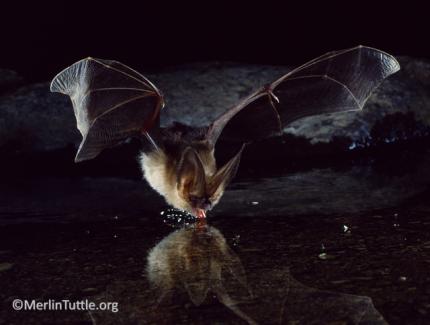
Provide a water source
If it is an option for you, you can provide a large water source that bats can use. Large water troughs (170 gallon has been shown to work) used for livestock can also benefit wildlife such as bats if it is kept filled to the top so that bats don’t have to swoop low into a container. If you use human-made water sources, be sure to include an escape route for small wildlife species. While bats can swim short distances, they cannot take off from the water and without an exit they will drown.
Wildlife escape ramps
Wildlife escape ramps are essential for all human-made water sources that do not have sloped sides. Wildlife can get trapped if ponds, troughs, basins, and other containers do not provide a safe exit point.
Wildlife escape ramps can be purchased or made and come in a variety of shapes and materials. Always include a way for wildlife to exit at the water level and safely travel out of the water source or an edge or shore where they can dry off and travel back into nature. Floating platforms, angled ramps, and submerged slopes can all serve this purpose.
Shelter and space
Bats use a variety of shelters (called roosts) throughout the year. They use a variety of habitats to roost such as caves, mines, bridges, bat houses, crevices and cavities in rocks and trees as well as bark, branches, and foliage. Most Washington species hibernate or migrate for the winter, while some others stay active in the winter, emerging to feed when nights are warmer, and insects are present.
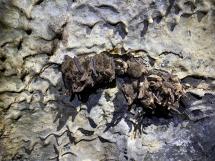
Bat roosts
Hibernacula: Roosts used for hibernation during fall, winter, and early spring. Limited information is available on winter roosting habitats of most Washington bat species, but generally they will hibernate in places where the temperature is cool and stable such as caves, mines, and crevices in rocks. Generally, bats appear to hibernate alone or in groups smaller than 25.
Maternity colony: A group of pregnant females living together in communal roosts to give birth and raise their pups. Most bats in Washington segregate by sex and reproductive status during the summer months. Bats are slow to reproduce, giving birth to a single pup each year, making them particularly vulnerable to threats due to their slow recovery. These roosts tend to be in warm, protected locations. Most maternity colonies in Washington contain a few to several hundred adult females, with a rare colony between 1,500-4,100 bats.
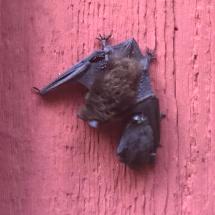
Day roost: Place where bats sleep during daylight hours in the spring, summer, and early fall, when not in hibernation.
Night roost: A place where bats stop to nap and digest food as they forage throughout the night. Most are occupied for very short periods ranging from less than a minute to a few hours. These roosts allow bats to rest and conserve energy, find protection, or socialize with other bats during their active hours. Pallid and Townsend’s big-eared bats are known to take food back to a night roost to eat, instead of eating in flight.
Transition roosts or migratory roosts: As maternity colonies disperse in late summer, or in the spring and fall as bats migrate, bats will roost for a day or two along their routes in the safest spot they can find.
Trees
Washington hosts several species of tree-dwelling bats, such as the long-legged myotis and silver-haired bats. Bats will roost in hollows, hanging among the branches, or blending into the bark. If you have a lot of bat activity in your area, but no bats in your bat house, don’t worry! Bats are active and roosting in the area, so the best thing to do is protect trees and forests.
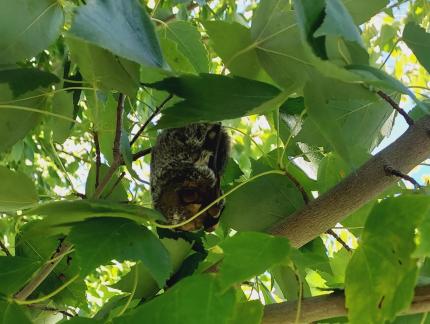
Trees provide protection for bats and are essential foraging areas because trees support many insects that bats eat. Some species will forage above the tree canopy searching for insects while other species hunt for insects among the foliage. Native trees support the highest diversity of insect species and are therefore the most beneficial to bats.
Tree loss is a major threat to local bat populations. Bats use trees differently during the year. In addition to foraging and roost sites, tree hallows are known to be used as maternity colonies where bats raise their pups, as hibernacula where bats hibernate through the winter, and as navigational aids for migratory species.
Native trees that bats use
- Douglas fir (Pseudotsuga menziesii)
- Ponderosa pine (Pinus ponderosa)
- Western red cedar (Thuja plicata)
- Quaking aspen (Populus tremuloides)
- Oregon white oak (Quercus garryana)
- Black Cottonwood (Populus trichocarpa)
Wildlife Tree (Snags)
Snags are standing dead trees in the early stages of decay. Decaying trees let off heat and create crevices bats (and other wildlife) love. Use our snag guidelines (PDF) to safely trim and preserve these important trees.
Native snags known to be used by bats
- Quaking aspen (Populus tremuloides)
- Douglas fir (Pseudotsuga menziesii)
- Ponderosa pine (Pinus ponderosa)
- Western red cedar (Thuja plicata)
- Western hemlock (Tsuga heterophylla)
- Mountain hemlock, (Tsuga mertensiana)
- Grand fir (Abies grandis)
Bat houses
Bat houses are a great way to help replace bat habitat lost to human development. They can provide shelter (called roosts) for maternity colonies, as well as shelter for foraging, migrating, and dispersing bats. Additionally, bat houses provide us with an opportunity to observe bats and the chance to educate friends on how they can support their neighborhood bats.

Follow our Bat House Care and Installation Guide (PDF) tips when building and placing a bat house in Washington.
- Full to partial sun: Bat houses need six or more hours of sunlight to keep bats warm. Place bat houses in a spot that will get good sunlight but doesn't overbake when temperatures are extra high.
- Paint: Painting bat houses a medium-to-dark color can help absorb and hold additional heat if your bat house is in a cool location. Dark paint is shown to increase internal bird house temperatures by up to 17 degrees Fahrenheit, so if the spot you choose is already hot in the spring and summer, then a lighter color or clear sealant might be enough. In Eastern Washington, decide if your bat house is going in full or part sun. Part sun can still be painted a medium or dark color, but in full sun in arid habitats houses should be a medium to light shade so bats don’t overheat.
- High off ground: Bat houses should be high off the ground, at least 12 feet, and away from any ledge or branches that would give predators access to get in or perch above. Consider installing baffling if the house is mounted on a 4x4 or similar post. Metal flashing or baffling installed about 5 to 6 feet up with help keep animals from climbing up the poll to reach the bats.
- Multiple chambers: Flat bat houses should have multiple chambers so bats can move into and away from heat as needed.
- Vents: make sure all bat houses have vents to increase airflow and keep bat houses from overheating.
- Large size: Bat houses should be large (at least 24”x24”) to fit many bats and allow for room to move. This will ensure bats can thermoregulate properly, cuddling when cold and spreading out to cool down when needed.
- Small openings: Openings and spaces in bat houses should be small (¾"-1 ½") so predators can’t get in and our small local bats feel safe.
- Rough surfaces: Wood surfaces below and inside bat houses should be roughed up so tiny bat claws can get a grip. Do not use mesh or screen materials in bat houses, because they can trap and damage bats’ tiny feet.
- Multiple options: If possible, put up multiple bat houses of different types and sizes, even different colors to give bats options to pick the best shelter for them. Not enough space? Try working with neighbors or local parks to differentiate the type of bat houses available to bats in your community.
Bat houses are mostly used in the spring, summer, and early fall months when bats are active raising young and hunting insects. Some species switch day roosts frequently, while many species are loyal to one roost, sometimes for years.
Some Washington species are highly adaptable and live in rural, suburban, and urban areas, but they still need space to thrive and stay protected. Put your bat house as far as you can from disturbances like walkways, loud garage doors, places with many people, or shelters set up for predators of bats such as owl boxes, squirrel feeders, or bird perches.
Types of bat houses
There are many resources about Northwest specific bat house styles, colors, and placement. Our website has resources for building plans for chamber houses (flat backed that can mount on a building) and rocket boxes (tall boxes that mount onto free standing poles). Providing different types of bat houses in one area can benefit bats by supporting more species and letting them pick the bat house that is best for them at any time.
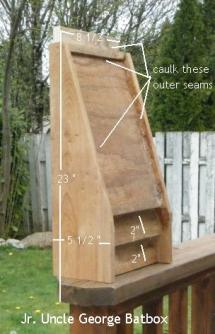
- Double-chamber flat bat house: (PDF) Best for placement on a building or post in a place that does not have a current maternity colony. Smaller, simplified bat house for solitary bats or non-maternity colonies.
- Single chamber Rocket box (PDF): Best for placement on standalone post in a place that does not have a current maternity colony. Smaller, simplified bat houses for solitary bats or non-maternity colonies.
- Multi-chamber George Junior: Best for providing a roost for small maternity colonies. Mounts well on buildings or on a post.
- Four-chamber nursery house (PDF): Best when needing to move a large maternity colony. Recommended for all of Washington and is especially ideal species who aggregate in large numbers like little brown or Yuma myotis. Can be mounted on a building or post.
- Dual-chamber Rocket box (PDF): Best when needing to move a large maternity colony. Recommended for all of Washington and is especially ideal for who aggregate in large numbers like little brown or Yuma myotis. Best mounted on a standalone post in a clearing 20 feet away from cover such as a tree line.
For an in-depth look at bat houses in the Pacific northwest, down Building Homes for Bats: A guide for bat houses in British Columbia (PDF), from Community Bat Programs of BC. While it focuses on Canada, the species and habitats are almost the same as Washington, making this guide relevant across the state.
Maintenance
Bat houses need maintenance. Don’t install a bat house in your area without a plan to maintain it. Abandoned bat houses become unusable to bats in a few short years, often before a bat colony can find it. Wasps, spiders, and others will make a home in a bat house and fill it with casings, brambles can grow to make entry by bats impossible, and overhanging limbs become perches for bat predators. Aside from checking it for occupants in the summer, winter is the best time to give your bat house a little love.
Video: How to maintain your bat house
Check for occupants
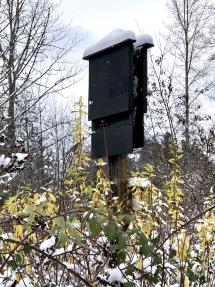
Before maintaining your bat house, check the house for occupants. Most bats will have moved on by late fall or early winter, but occasionally bats will use a bat house in the winter. If you bat house is occupied, leave it be and check back a few days or weeks late. You can check for occupancy in two ways:
- Use a flashlight to thoroughly view the inside of your bat house. Check the corners and all chambers.
- On a dry stretch of days set out white paper, sheet, or towels under the bat house. Leave the textiles out a few nights to see if guano collects. Guano is bat poop and is usually small, dark, and oblong. It looks like mouse poop but is dry and slightly shimmery when crushed.
Clean out
To clear out the inside of the house of any insects, webbing, or casing you can use a high-powered hose or a long stick with paper towels tightly wrapped around the top. Clear out all chambers and be sure to get the corners. White-nose syndrome is caused by a fungus that can be spread easily spread between bat habitats. Be sure not to use the same cleaning implements between bat houses.
Report bat observations
If you have a colony living in your bat house at any point in the year, please report it to WDFW so that our bat biologists can contact you. If white-nose syndrome is found at your location, please work with WDFW’s bat biologist for the best care and maintenance of your location.
Repair
After clearing out the bat house, look it over to see what maintenance is required. Touch up paint if needed, re-caulk to keep the house from leaking, examine the roof for leaks, and check that vents are not clogged to provide proper airflow. Make sure the post is not rotten or leaning, and that the bat house is still securely mounted.
Maintain
Clear the surrounding area by cutting back brambles and branches that might be moving into space. This allows bats to exist the bat house without fear of predators perched above. Bats need gravity to drop out of the house and take flight, so make sure underbrush is not encroaching on the area underneath the bat house. Bat houses should be 10 to 12 feet high (of cleared space) and have about a 15 to 20-foot diameter around the building or post.
Viewing bats
Observing bats in flight or leaving a roost can be a great way to connect with a nocturnal species that we do not encounter often. Avoid seeking out bats in caves, mines, or other roosting areas, as this can disrupt and harm sleeping bats or growing babies. Disturbance during hibernation can cause bats to wake, burning their critical fat reserves needed to survive during the winter. If bats are disturbed during daytime in the summer, adults may abandon newborn pup, abandon their roost for a use a less suitable one or flee into the daylight where they are in danger from predators.

The best way to observe bats is to view them in the open sky starting 20-30 minutes before sunset until the time of last light, usually 30-60 minutes after official sunset.
Look for bats in warm months when insects are present (usually March-Oct.). Find a spot with open sky where you can see the silhouette of a bat against the dimming light.
Bats often will look for a place to get a drink right after they wake up. Since they cannot land to drink, they often head to a large fresh water source like a lake, slow river, stream or pond. Watching for bats near one of these water sources (or within about quarter of a mile) will increase your odds of seeing bats.
You can tell it’s a bat and not a bird by watching how it flies. Bats follow insects in flight and fly in more erratic flight patterns that most birds, they also flap their wings continuously instead of gliding or diving. If you follow the flight pattern you will often get a glimpse of the stereotypical “bat signal” outline in the sky. Bats are also quite small in Washington, with wingspans from 7”-16” across. This puts them closer in size to a robin, and much smaller than a duck or a crow in flight.
BAT community science
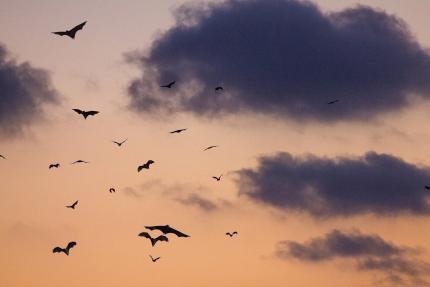
You can learn more about observing bats and try a bat observation yourself by participating in the Bat Activity Trends community science program. The community science program asks you to go outside in June, July, or August and watch the skies for 30 minutes, starting right after sunset. Count each bat you see as it passes by, record the total number after 30 minutes, and submit the number online.
This program is a great way to get outside and observe bats right where you live and help support conservation efforts in our state. Learn more about the BAT program and how you can participate.
Helping bats

White-nose Syndrome, wind energy, and habitat loss
Trees and wetlands are essential habitat for most local species, and habitat loss is very impactful on local populations. Increased forest fires threated some Eastern Washington species whose specialized habitat needs limit them to very specific areas, susceptible to big impacts by fire.
White-nose syndrome is a fungus that impacts bat species while they are hibernating. The fungus depletes their valuable energy resources leading to dehydration and starvation and can damage their wings to the point that they cannot fly to feed themselves.
Another major threat to bats in Washington is the construction of wind turbines in areas traveled by migratory bats. Our largest bat species are also our longest migrators and are being most impacted by wind turbines on the landscape. Estimates put fatalities due to wind turbines at 500,000 to one million per year in North America alone. As wind energy increase across the country, fatalities will increase as well unless mitigating steps are taken when bats are migrating in the spring and fall.
Keep cats indoors
Domestic cats are talented predators of bats. Because of their efficient hunting tactics, house cats kill millions of birds, reptiles, amphibians, and small mammals which impacts local wildlife populations dramatically. Additionally, cat feces can spread disease to wildlife. Instead of letting your cats outside, build them a contained outdoor catio or provide enrichment inside. Keeping cats indoors keeps both your cats and local wildlife safer.
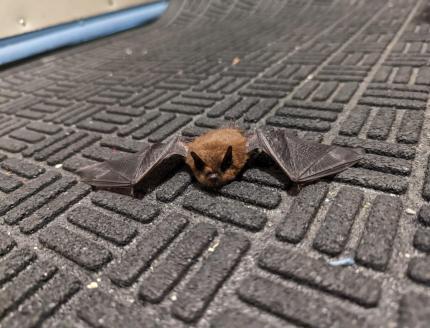
Keep the lights off
Artificial Light At Night (ALAN) is the light produced by our streetlights, billboards, buildings and more. These artificial light sources disrupt the natural patterns of wildlife, especially in our cities and towns. It can effect when wildlife are active, where they find food sources, and how they hunt. Keeping outdoor lights off at night when not in use, can help wildlife use their habitats more naturally. If you can't turn lights off, consider using a yellow or red light, or covering lights so they point at the ground without shining up into the skies as much.
Report a colony or found bat
Report sick, injured, or dead bats online. Please also report groups of bats. These reports provide valuable information to track bat populations in Washington.
What to do if you find a bat
- Do not touch the bat. Leave it in place unless advised to move it.
- If the bat must be moved, use thick gloves and a shovel or box to gently pick it up and move it to a protected and elevated location, like a tree. Most bat species have difficult time taking to flight from the ground.
- Remember - a small percentage of bats can carry rabies. If you have touched a bat or suspect exposure, contact your local Department of Health immediately.
- If you have a nuisance bat or colony that you need removed or excluded, please contact a Wildlife Control Operator in your area.
Resources
For more bat facts, Washington species, information on excluding bats from buildings, bat houses, and avoiding conflicts with bats please visit the Living with Bats webpage.
References
- Hayes, G. and G.J. Wiles. 2013. Washington bat conservation plan. Washington Department of Fish and Wildlife, Olympia, Washington. 138+viii pp.
- Hayes, M. A. (2013). Bats killed in large numbers at United States wind energy facilities. BioScience, 63(12), 975-979.
- Kellner, A. & Harestad, A. (2005, Sept 1). Diets of Bats in Coastal Rainforests on Vancouver Island, British Columbia. Northwestern Naturalist 86(2), 45-48.